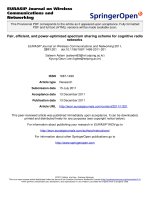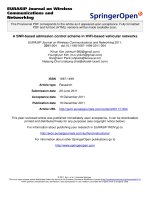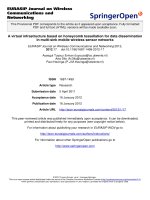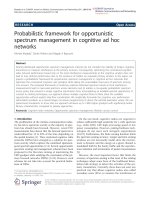MOBILE NETWORKS pot
Bạn đang xem bản rút gọn của tài liệu. Xem và tải ngay bản đầy đủ của tài liệu tại đây (11.31 MB, 184 trang )
MOBILE NETWORKS
Edited by Jesús Hamilton Ortiz
Mobile Networks
Edited by Jesús Hamilton Ortiz
Published by InTech
Janeza Trdine 9, 51000 Rijeka, Croatia
Copyright © 2012 InTech
All chapters are Open Access distributed under the Creative Commons Attribution 3.0
license, which allows users to download, copy and build upon published articles even for
commercial purposes, as long as the author and publisher are properly credited, which
ensures maximum dissemination and a wider impact of our publications. After this work
has been published by InTech, authors have the right to republish it, in whole or part, in
any publication of which they are the author, and to make other personal use of the
work. Any republication, referencing or personal use of the work must explicitly identify
the original source.
As for readers, this license allows users to download, copy and build upon published
chapters even for commercial purposes, as long as the author and publisher are properly
credited, which ensures maximum dissemination and a wider impact of our publications.
Notice
Statements and opinions expressed in the chapters are these of the individual contributors
and not necessarily those of the editors or publisher. No responsibility is accepted for the
accuracy of information contained in the published chapters. The publisher assumes no
responsibility for any damage or injury to persons or property arising out of the use of any
materials, instructions, methods or ideas contained in the book.
Publishing Process Manager Jana Sertic
Technical Editor Teodora Smiljanic
Cover Designer InTech Design Team
First published April, 2012
Printed in Croatia
A free online edition of this book is available at www.intechopen.com
Additional hard copies can be obtained from
Mobile Networks, Edited by Jesús Hamilton Ortiz
p. cm.
ISBN 978-953-51-0593-0
Contents
Preface VII
Chapter 1 Mechamisms to Provide Quality of
Service on 4G New Generation Networks 1
Jesús Hamilton Ortiz, Bazil Taja Ahmed,
David Santibáñez and Alejandro Ortiz
Chapter 2 A QoS Guaranteed Energy-Efficient
Scheduling for IEEE 802.16e 33
Wen-Hwa Liao and Wen-Ming Yen
Chapter 3 A Fast Handover Scheme for
WiBro and cdma2000 Networks 55
Choongyong Shin, Seokhoon Kim and Jinsung Cho
Chapter 4 Design and Analysis of IP-Multimedia Subsystem (IMS) 67
Wagdy Anis Aziz and Dorgham Sisalem
Chapter 5 Dynamic Spectrum Access in
Cognitive Radio: An MDP Approach 95
Juan J. Alcaraz, Mario Torrecillas-Rodríguez,
Luis Pastor-González and Javier Vales-Alonso
Chapter 6 Call Admission Control in Cellular Networks 111
Manfred Schneps-Schneppe and Villy Bæk Iversen
Chapter 7 Femtocell Performance Over
Non-SLA xDSL Access Network 137
H. Hariyanto, R. Wulansari, Adit Kurniawan and Hendrawan
Chapter 8 Sum-of-Sinusoids-Based Fading
Channel Models with Rician K-Factor and
Vehicle Speed Ratio in Vehicular Ad Hoc Networks 157
Yuhao Wang and Xing Xing
Preface
The growth in the use of mobile networks has come mainly with the third generation
systems and voice traffic. With the current third generation and the arrival of the 4G, the
number of mobile users in the world will exceed the number of landlines users. Audio
and video streaming have had a significant increase, parallel to the requirements of
bandwidth and quality of service demanded by those applications. Mobile networks
require that the applications and protocols that have worked successfully in fixed
networks can be used with the same level of quality in mobile scenarios.
One of the main differences between fixed and mobile networks lies in the dynamic
nature of the latter. The constant movement of mobile devices has a clear impact in the
quality of service that can be achieved (delay or loss of packets during a handover
from one cell to another). The migration of mechanisms initially meant for fixed
networks to mobile networks may cause problems related to topology and mobility
factors. Other difficulties may appear when we want to move mechanisms designed
for infrastructure and wired networks to ad-hoc or mobile networks in general. These
are some of the drawbacks:
Problems related to topology:
One of the great remaining difficulties from the first generation to the fourth
generation of mobile devices occurs when there is a handover, either from one cell to
another or from one access network to another. This circumstance clearly affects the
quality of service in diverse ways: delay of packet transfers, increase of the jitter of
audio and video streaming or even damage or loss of packets. There are different
types of handovers that produces diverse signalling loads in the access network. A
handover involves a route variation in order to reach the mobile terminal. To provide
a good level of QoS in mobile environments, a minimal handover delay is always
welcome to ensure the smallest traffic interruption during a transfer.
Problems related to mobility: macromobility and micromobility.
Macromobility: Mobile terminal activity between different access networks or
domains (inter-domain).
Micromobility: Mobile terminal activity inside one access network only (intra-
domain).
VIII Preface
Although the two types of handovers occur under both circumstances, intra-domain
handovers will be a priority due to their higher frequency of signalling load and
packet transfers. One of the greatest difficulties in reducing the mobility impact in the
terminals when there is a handover is that the protocols or mechanisms to provide
quality of service are designed and limited to a certain kind of fixed or mobile
networks or at macromobility level. Using these existing mechanisms of QoS involves
adapting the dynamic characteristics of the mobile devices. There are cases such as ad-
hoc networks that have special mobility specifications, making migration a complex
challenge.
Until the third generation of mobile networks, the need to ensure reliable handovers
was still an important issue. On the eve of a new generation of access networks (4G)
and increased connectivity between networks of different characteristics commonly
called hybrid (satellite, ad-hoc, sensors, wired, WIMAX, LAN, etc.), it is necessary to
transfer mechanisms of mobility to future generations of networks. In order to achieve
this, it is essential to carry out a comprehensive evaluation of the performance of
current protocols and the diverse topologies to suit the new mobility conditions.
Dr Jesús Hamilton Ortiz
School of Computer Engineering,
University of Castilla La Mancha, Ciudad Real
Spain
1
Mechamisms to Provide Quality of
Service on 4G New Generation Networks
Jesús Hamilton Ortiz, Bazil Taja Ahmed,
David Santibáñez and Alejandro Ortiz
University of Castilla y la Mancha
Spain
1. Introduction
1.1 New generation nerworks (4G)
Currently, the 3
rd
Generation Partnership Project forum (3GPP) is working to complete the
standard that aims to ensure the competitiveness of UMTS in the future. As a result of this
work, in 2004 the Long Term Evolution project (LTE) arises, which is expected to become the
4G standard. We can find the requirements for 4G standardization in recent works like
“Release 10” and “Advanced LTE”.
On the other hand, the System Architecture Evolution (SAE) is a project that seeks to define
a new core component of the all-IP network called Evolved Packet Core (EPC). We can
consider IPv6/MPLS as part of the development of the LTE standard included in the all-IP
concept to meet some requirements of LTE, such as end-to-end quality of service (MPLS,
Diffserv, IntServ). SAE allows interoperability with existing technologies in both the core
and access networks.
The figure 1 shows the relation between 2G, 3G & LTE technologies and the packet core that
is intended to evolve with SAE.
Due to the increasing demand of QoS by users, it is necessary to adopt mechanisms to
ensure the requirements of LTE/SAE. As is well known, an all-IP network provides the so-
called Best Effort quality of service. For this reason, in order to provide QoS to the LTE/SAE
network's core and to the access networks, we propose the implementation of IPv6
(extensions/MPLS into the Evolved Packet Core (EPC).
1.2 Requirements of LTE/SAE
Some of the most important requirements of LTE/SAE are:
Low cost per bit.
Increase of the services provided: more services at lower cost to improve the user’s
experience.
Flexible use of existing and new frequency bands.
Simplified architecture.
Mobile Networks
2
Fig. 1. LTE/SAE
Reasonable energy consumption.
In addition to the requirements mentioned above, there would be other important
requirements as part of the standard, such as throughput optimising, latency reduction and
end-to-end QoS for both the core and the access networks. In order to improve these
conditions, we have considered the handover a priority. One of the key elements in the all-
IP concept is the MPLS protocol as a fundamental part of all IPv6/MPLS architecture to
provide quality of service to access networks and core network since it will be compatible
with other architectures in the next generation mobile networks.
1.3 MPLS
In 1996, companies like Nokia, Cisco, IBM and Toshiba, among others, introduced
proprietary solutions to the problem of multilayer switching. This was not only a solution to
integrate ATM with IP, but offered brand new services. Unfortunately, these solutions were
not compatible despite the large number of aspects in common. MPLS (Multi-Protocol Label
Switch) came up from the work of the IETF in 1997 to standardise the proprietary multilayer
switching technologies mentioned above. The main feature of MPLS is the combination of
layer 3 routing and the simplicity of level 2 switching.
Another important feature of MPLS is that it provides a good balance between connection-
oriented technologies to improve non-IP connection-oriented mechanisms (they can only
deliver a Best Effort level of service). On the other hand, MPLS adds labels to the packets, so
no routing is based on layer 3 addresses but in label switching. This allows interoperability
between IP and ATM networks. It also increases the speed of the packets traversing the
network because they do not run complex routing algorithms at every hop; they are
forwarded considering the packet's label only. This labelling system is also very useful to
classify the incoming traffic according to its higher or lower QoS requirements contracted or
required.
Mechamisms to Provide Quality of Service on 4G New Generation Networks
3
Since MPLS is a standard solution, it also reduces the operational complexity between IP
networks and gives IP advanced, routing capabilities in order to use traffic-engineering
techniques that were only possible on ATM.
1.4 IPv6 extensions
The extensions of the IPv6 protocol were designed to migrate IPv6 to mobile environments.
There are several extensions of IPv6 designed with this purpose. We have chosen the
following IPv6 extensions: HMIPv6, FHMIPv6 and FHAHMIPv6, The first and second
extensions were designed to be used at micro-level mobility, because the signalling, lad at
this level is higher, With regards to the FHAMIPv6 protocol, this is a protocol that we have
designed to provide hierarchical addresses support in an ad hoc network.
1.5 IPv6/MPLS on LTE/SAE
So far, we have briefly described what LTE/SAE consists of, the current requirements that
have to be met to become the 4G standard and the most relevant concepts related to MPLS.
Let us now look into the importance of supporting the LTE/SAE core with IP/MPLS.
The use of MPLS on LTE allows reusing much of 2G and 3G technologies, which means a
low cost per bit. In addition, MPLS can handle the IP requirements for the wide range of
services it supports. MPLS also supports any topology, including star, tree and mesh. On the
other hand, IPv6/MPLS can give IP advanced traffic engineering, ensuring that traffic is
properly prioritised according to its characteristics (voice, data, video, etc.) and the routes
through the network are set up to prevent link failures. The use of differentiated services is
also an important feature of MPLS, since Forwarding Equivalent Class (FEC) can perform
different treatments to the services provided by IP, including an eventual integration with
Diffserv. This contributes to provide a better quality of service (QoS).
In addition, because MPLS creates virtual circuits before starting the data transmission and
uses special labelling, it is possible to deliver a better level of security when packets
experience higher rates of transmission and processing, since the forwarding is performed
according to the label without routing algorithms. This is another important aspect of
IPv6/MPLS in order to meet the requirements related to the throughput. Finally, MPLS
promotes the simplification of the integration architecture of IP and ATM and improves the
users’ QoS experience providing redundant paths to different FECs to prevent packet loss.
The following figure shows how the transition to IPv6/MPLS will be as part of LTE.
Service providers and network operators want to ensure that their Radio Access Network
(RAN) is able to support current technologies such as GSM and UMTS and new
technologies such as LTE and WIMAX. At the same time, future broadband requirements
must be met in an efficient and effective way. That is why service providers are choosing
solutions based on IPv6/MPLS. This technology can fulfil current and future needs while
reducing costs.
It is important to point out that the standard WIMAX and advanced WIMAX or mobile
WIMAX, which is part of the evolution of IEEE (802.11, 802.16, etc.), complies with the
requirements for 4G standard. WIMAX (802.16) can operate in both the core and access
networks with IPv6/MPLS.
Mobile Networks
4
Fig. 2. LTE to IP/MPLS and EPC
Currently, there is competition for the dominant 4G standard. Advanced LTE has a higher
market share than advanced WIMAX because it is part of the evolution of GSM and UMTS
networks and represents 80% of the worldwide market. However, WIMAX today has a
significant market share in the United States. We believe that both LTE and WIMAX meet
standard requirements and are compatible with the architectures proposed for an all
IPv6/MPLS approach both in access networks as the core of the network.
This chapter is focusing in the integration of mobility protocol (IPv6 extensions) and the
protocol of quality of services (MPLS). The RSVP protocol has been used as signalization
protocol. The metrics of quality of services tested are: Delay, jitter, throughput, the send and
received packets, these metrics were chosen because they are the most sensitives in a
handover. The integrations tested in this chapter were: HMIPv6/MPLS, FHM IPv6/MPLS,
FHAMIPv6/AODV and FHAMIPv6/MPLS. In order to achieve these integration was
necessary modify the source codes and adapt the simulator versions (NS-2). In order to
integrated protocols performance as a new protocol.
2. HMIPv6/MPLS integration
In response to the demands of multimedia services on existing mobile systems, cellular areas
will have a smaller radius in order to support higher throughput, ensuring acceptable error
rates. Having small cells means that the MN can cross borders more frequently and signalling
capacity will increase rapidly. In this section, we will integrate HMIPv6 and MPLS. The
architecture used is the proposal by Robert Hsieh. We use us the scenario base (R. Hsieh) and
then increasing the number nodes and flow of traffic in order to analyse the scalability of this
integration. We analyse the relationship between the different metrics and the number nodes,
the main idea is that in an handover the metrics of quality of service will be optimized or by
default it’s were not degraded. The metrics used were: delay, jitter, send and received packets
and throughput. This metrics were chosen because they are most sensitive in a handover.
In other work, was evaluating the HMIPv6/MPLS integration, this works were tested in
different scenarios [2,],[8],[9],[10] the integrations were HMIPv6/MPLS/RSVP and the
Mechamisms to Provide Quality of Service on 4G New Generation Networks
5
simulation scenario was made in a LAN and WAN networks. In these integrations, the
RSVP protocol was used as signalling protocol while hierarchical MPLS nodes were used to
achieve interoperability of HMIPv6 and MPLS.
The results obtained in [2],[8],[9],[10] showed that this interoperability is a good alternative
to provide QoS in LAN and WLAN networks. In order to better the load signalisation in a
handover, in case of Binding Update the HMIPv6/MPLS was used as preliminary work
with the idea of future integration FHMIPv6/MPLS and FHMIPv6/MPLS in Ad hoc
networks.
2.1 HMIPv6/MPLS integration in a scenario with CBR
2.1.1 Simulation scenario
The scenario simulated is shown (R. Hsieh) in figure 3. The MN is in the area of HA. The
traffic used was CBR because is most sensitive in audio/video application. The Bandwidth
configuration and delay of each link go as follows:
Link Delay Bandwidth
CN-LSR1 2ms 100Mb
LSR1-HA 2ms 100Mb
LSR1-MAP 50ms 100Mb
MAP-LSR2 2ms 10Mb
MAP-LSR3 2ms 10Mb
LSR2-PAR 2ms 1Mb
LSR3-NAR 2ms 1Mb
Table 1. Simulation scenarios
The traffic used was CBR, since it allows audio and video simulation in real time. These
applications have a high demand of QoS.
The figure 3 shows the topology of the simulated network. MPLS is the core of the network
and is constituted by the following nodes: 1 (MAP), 2 (LSR1), 3 (LSR2), 4 (LSR3), 7 (LER1 for
MPLS and PAR for HMIPv6) and 8 (LER2 for MPLS and NAR for HMIPv6); the tag
distribution protocol used by MPLS is RSVP. Finally number 6 is the MN.
Every link shows two of their characteristics: bandwidth (in megabits or kilobits) and delay
(in milliseconds).
The figure 3 shows the topology of the simulated network. MPLS is the core of the network
and is constituted by the following nodes: 1 (MAP), 2 (LSR1), 3 (LSR2), 4 (LSR3), 7 (LER1 for
MPLS and PAR for HMIPv6) and 8 (LER2 for MPLS and NAR for HMIPv6); the tag
distribution protocol used by MPLS is RSVP. Finally number 6 is the MN.
Every link shows two of their characteristics: bandwidth (in megabits or kilobits) and delay
(in milliseconds).
A few seconds later MN moves toward area PAR/LER as the figure 4 illustrate, finally the
MN moves to area NAR/LER as the figure 5 illustrates.
Mobile Networks
6
Fig. 3. Scenario of HMIPv6/MPLS simulation
Fig. 4. MN moves the area PAR/LER
Fig. 5. MN moves the area NAR/LER
Finally, the MN moves to area NAR/LER as the figure 5 illustrates.
Mechamisms to Provide Quality of Service on 4G New Generation Networks
7
2.1.2 Description of simulation
Initially, the MN is located in the area of the HA. 2 seconds after the start of the simulation,
the HA moves towards the area of the PAR at 100 m/s, arriving at t=3.5 s approximately. At
t=5 s, the CN begins sending CBR traffic to the MN following the route
CN→LSR1→HA→LSR1→MAP→LSR2→PAR-MN as shown in figure 3. Then, at t=10 s, the
MN starts moving to the area of the NAR at 10 m/s. At the same time, the handover takes
places at around t=13.12 s and the MN receives one of the first packets from the NAR.
Afterwards, the MN places in the area of the NAR at around t=17 s. Finally, at t=19 s, the
CN stops sending traffic flow towards the MN.
Simulation scenarios
Fig. 6. Scenario with 9 nodes Figure
Fig. 7. Scenario with 15
Mobile Networks
8
Fig. 8. Scenario with 20 nodes
Fig. 9. Scenario with 25 nodes
Fig. 10. Scenario with 30 nodes
Mechamisms to Provide Quality of Service on 4G New Generation Networks
9
Fig. 11. Scenario with 35 nodes
Fig. 12. Scenario with 40 nodes.
Fig. 13. Scenario with 45 nodes.
2.2 Scalability
The objective of this simulation with different scenarios was to analyse QoS metrics in
HMIPv6/MPLS integration with CBR traffic and the scalability. The table2 show the
different scenarios simulated. The first scenario was proposal by R.Hsieh, the other
scenarios were increasing the number nodes in order to test the scalability, the table show
the results of different metrics analysed.
Mobile Networks
10
Scenario\
Metrics
Delay(ms) Jitter(ms) Throughput
(Kbps)
Sends
Packets
Received
Packets
Lost
Packets (%)
9 Nodes 66,85 0,46 424,80 3734 3734 0%
15 Nodes 226,66 1,97 356,11 3734 3151 15,61%
20 Nodes 254,70 1,84 359,60 3734 3204 14,20%
25 Nodes 317,92 4,0 277,60 3734 2476 33,70%
30 Nodes 310,73 3,60 288,27 3734 2571 31,15%
35 Nodes 312,95 3,80 279,96 3734 2497 33,13%
40 Nodes 331,80 4,31 268,22 3734 2392 35,94%
45 Nodes 341,70 4,60 261,90 3467 2156 37,81%
Table 2. Results of different scenarios HMIPv6/MPLS integration
The table 2 shows the results of HMIPv6/MPLS integration. The metrics analysed were:
delay, jitter, throughput, sent packets, received packets and lost packets. From the results
obtained, we can affirm that, in general, the delay increases as the number of nodes
increases. The jitter grows significantly when there are more than 25 nodes. The
throughput shows a slight variation, but it does not follow a particular pattern. Sent
packets, normally, remain constant; the received packets, generally, decrease as the
number of nodes grows and the number of lost packets increases significantly when there
are more than 25 nodes.
The figure 14 shows the results of the following metrics obtained of the table 2. In this
manner can visualize the behaviour of delay, throughput, send and received packets against
the quantity of number of nodes.
Fig. 14. Delay, throughput, send an received packets Vs. Number nodes
0
2000
4000
9 15202530354045
Delay, Throughput, Sends and Received Packets Vs
Nodes
Delay(ms) Throughput (Kbps) Sends Packets Received Packets
Mechamisms to Provide Quality of Service on 4G New Generation Networks
11
In order to extend the different results obtained in the simulations, the functions (figure15)
show the behaviour of the different simulation scenarios. With these functions we could
predict what will happen with the metrics (Delay, Throughput, Send and Received Packets)
against the number of nodes. In this manner, we could predict what happen when the
number of nodes and flow are traffic is increased.
Fig. 15. The functions show the scalability of Delay, Throughput, send and received packets.
y = -0.3203x
2
+ 23.585x - 91.681
y = 0.148x
2
- 12.292x + 520.02
y = -4.3337x + 3819.3
y = -941.5ln(x) + 5782
0
500
1000
1500
2000
2500
3000
3500
4000
0 1020304050
Nodes
Delay, Throughput, Sends and Received Packets Vs
Nodes
Delay(ms)
Throughput
(Kbps)
Sends Packets
Received Packets
Mobile Networks
12
The figure 16 shows the results of the following metrics obtained of the table 2. In this
manner can visualize the behaviour of Jitter and Lost Packets with different number nodes.
Fig. 16. Jitter and Lost Packets vs. Number nodes
In order to extend the different results obtained in the simulations, the function (figure17)
shows the behaviour for different scenarios of simulation. With this functions (Jitter, Lost
Fig. 17. The functions show the scalability of Jitter and Lost Packets vs. Number nodes
0
5
10
15
20
25
30
35
40
9 15202530354045
Jitter and Lost Packets Vs Nodes
Jitter(ms) Lost Packets (%)
y = 2.5821ln(x) - 5.1811
y = 23.898ln(x) - 51.198
0
5
10
15
20
25
30
35
40
45
0 1020304050
Nodes
Jitter and Lost Packets Vs Nodes
Jitter(ms)
Lost Packets (%)
Mechamisms to Provide Quality of Service on 4G New Generation Networks
13
Packets) against the number of nodes. In this manner, we could predict what happen when
the number of nodes and flow are traffic is increased.
2.3 Conclusions
In this case, we performed the HMIPv6/MPLS scenario simulation using CBR as test traffic.
Various QoS metrics were analysed, such as delay, which on average was 66,82 ms; the
jitter, which was rather variable, and throughput, which reached 446,0 Kbps on average. On
the other hand, in the course of the simulation, 3,74 packets were sent and 207 were lost; that
represents 5,54% of all packets. Therefore, we conclude that the simulation scenario showed
very good values of delay and throughput, acceptable packet loss and very irregular jitter
figures, so that, in order to achieve good levels of QoS, the performance of jitter has to be
improved. A similar scenario with FHMIPv6 instead of HMIPv6 could solve this point.
3. FHMIPV6/MPLS integration
One of the major problems encountered in the integration HMIPv6/MPLS is the amount of
signaling load in Binding Update (BU). Especially in case of a handover. At the time of BU
can cause problems of safety and quality of services. With respect to security can be sent or
received malicious messages, relative to the quality of services, excessive signaling load can
significantly degrade the QoS metrics evaluated.
For this reason, we propose FHMIPv6/MPLS integration as a mechanism that will avoid
both these problems. FHMIPv6 has a process of pre and post registration which keeps the
communication between the mobile node and access router. FHMIPv6 has a process of pre
and post registration which solves the problem observed in HMIPv6/MPLS integration.
This we can say based on the work of R. Hsieh. FHMIPv6/MPLS integration has been made
in the same manner as HMIPv6/MPLS integration. This integration allows us to compare
which is better.
Is important mentioned, Fast Handover for Mobile IPv6 (FMIP) is a mobile IP extension that
allows the MN to set up a new CoA before a change of network happens. This is possible
because it anticipates the change of the router of access when an imminent change of point
of access is detected. This anticipation is important because it minimises the latency during
the handover, when the MN is not able to receive packets.
FHMIPv6 had been initially proposed by Robert Hsieh [hsieh03] as a way of integrating Fast
Handover and HMIPv6 and shows why this integration is a better option than HMIPv6
alone.
3.1 Scenario of simulation
The scenario simulated is shown in figure18. The MN is in the area of HA. Bandwidth
configuration and delay of each link are shown below in table3.
The traffic used was CBR, since it allows audio and video simulation in real time. These
applications have a high demand of QoS.
Figure18 shows the topology of the simulated network. MPLS is the core of the network and
is constituted by the following nodes: 1 (MAP), 2 (LSR1), 3 (LSR2), 4 (LSR3), 7 (LER1 for
Mobile Networks
14
Link Delay Bandwidth
CN-LSR1 2ms 100Mb
LSR1-HA 2ms 100Mb
LSR1-MAP 50ms 100Mb
MAP-LSR2 2ms 10Mb
MAP-LSR3 2ms 10Mb
LSR2-PAR 2ms 1Mb
LSR3-NAR 2ms 1Mb
Table 3. Bandwidth and delay configuration
MPLS and PAR for F-HMIPv6) and 8 (LER2 for MPLS and NAR for F-HMIPv6); the tag
distribution protocol used by MPLS is RSVP.
Fig. 18. Scenario FHMIPv6/MPLS Integration
Every link shows two of their characteristics: bandwidth (in megabits or kilobits) and delay
(in milliseconds). A few seconds later, the MN moves towards the area of PAR, as figure 19
proves.
Finally, the MN moves to the area of NAR (figure20).
3.2 Description of simulation
Initially, the MN is located in the area of the HA. 2 seconds after the start of the simulation,
the HA moves towards the area of the PAR at 100 m/s, arriving at t=3,5 s approximately. At
t=5 s, the CN begins sending CBR traffic to the MN following the route
CN→LSR1→HA→LSR1→MAP→LSR2→PAR→MN as shown in figure 19. Then, at t=10 s,
the MN starts moving to the area of the NAR at 10 m/s. At the same time, the handover
takes places at around t=13,12 s and the MN receives one of the first packets from the NAR
at t=13,14 s approximately. Afterwards, the MN places in the area of the NAR at around
t=17 s. Finally, at t=19 s, the CN stops sending traffic flow towards the MN.
Mechamisms to Provide Quality of Service on 4G New Generation Networks
15
Fig. 19. The MN moves towards the area of PAR
Fig. 20. The MN moves to the area of NAR
3.3 Scalability
The objective of this simulation with different scenarios was to analyse QoS metrics in
HMIPv6/MPLS integration with CBR traffic and the scalability. The table4 show the
different scenarios simulated. The first scenario was proposal by R.Hsieh, the other
scenarios were increasing the number nodes in order to test the scalability, the table show
the results of different metrics analysed.
The table4 shows that the delay, jitter, throughput and packet loss rate vary slightly as the
topology and the network flow increase. Therefore, we can conclude that the
FHMIPv6/MPLS integration keeps the quality of service (QoS) high, despite the growth of
the network and the traffic flow.









